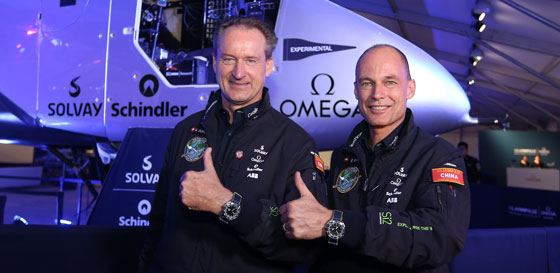
The Solar Impulse project is well under way in its attempt to make the first solar powered flight around the world and has already successfully completed several stages of the mission. Twelve years of preparation were needed to get this magnificent adventure off the ground.
Omega joined the Solar Impulse team in 2006 and has since contributed to the project by introducing numerous technological innovations such as the development of a beacon landing system, an instrument indicating the aircraft’s flight trajectory which also warns the pilot if wing angles exceed a specific limit, a warning system causing the sleeves of the pilot’s suit to vibrate so that he can respond in good time to critical information provided by on-board instruments, an AC-DC transformer to convert energy from the aircraft’s batteries into low-current voltage (28 V), and an energy distributor which ensures that each battery is capable of assisting the other in the event of motor failure.
Another important instrument also making the trip is the Speedmaster Skywalker X-33 Solar Impulse Limited Edition timepiece worn by Bertrand Piccard and André Borschberg, the pilots of the solar plane and the instigators of this groundbreaking project. This watch is equipped with three time-zones, three alarms, and chronograph and countdown functions, as well as a perpetual calendar indicating the day, date, month, year and week number. The timepiece is powered by the Omega 5619 multifunction quartz movement. It also has two other very useful functions for the pilots: mission elapsed time and phase elapsed time. The caseback bears an engraving of the mission logo «Around the World» and the words «Tested and qualified by ESA» (European Space Agency). The special edition will comprise 1,924 pieces, commemorating the year of the first round-the-world flight by members of the American air force (4 September 1924).
The solar aircraft took off from Abu Dhabi on 9 March this year and is expected to complete its circumnavigation of the globe in around five months, including 25 effective flying days spread over twelve stages.
June 04, 2015


 News
News